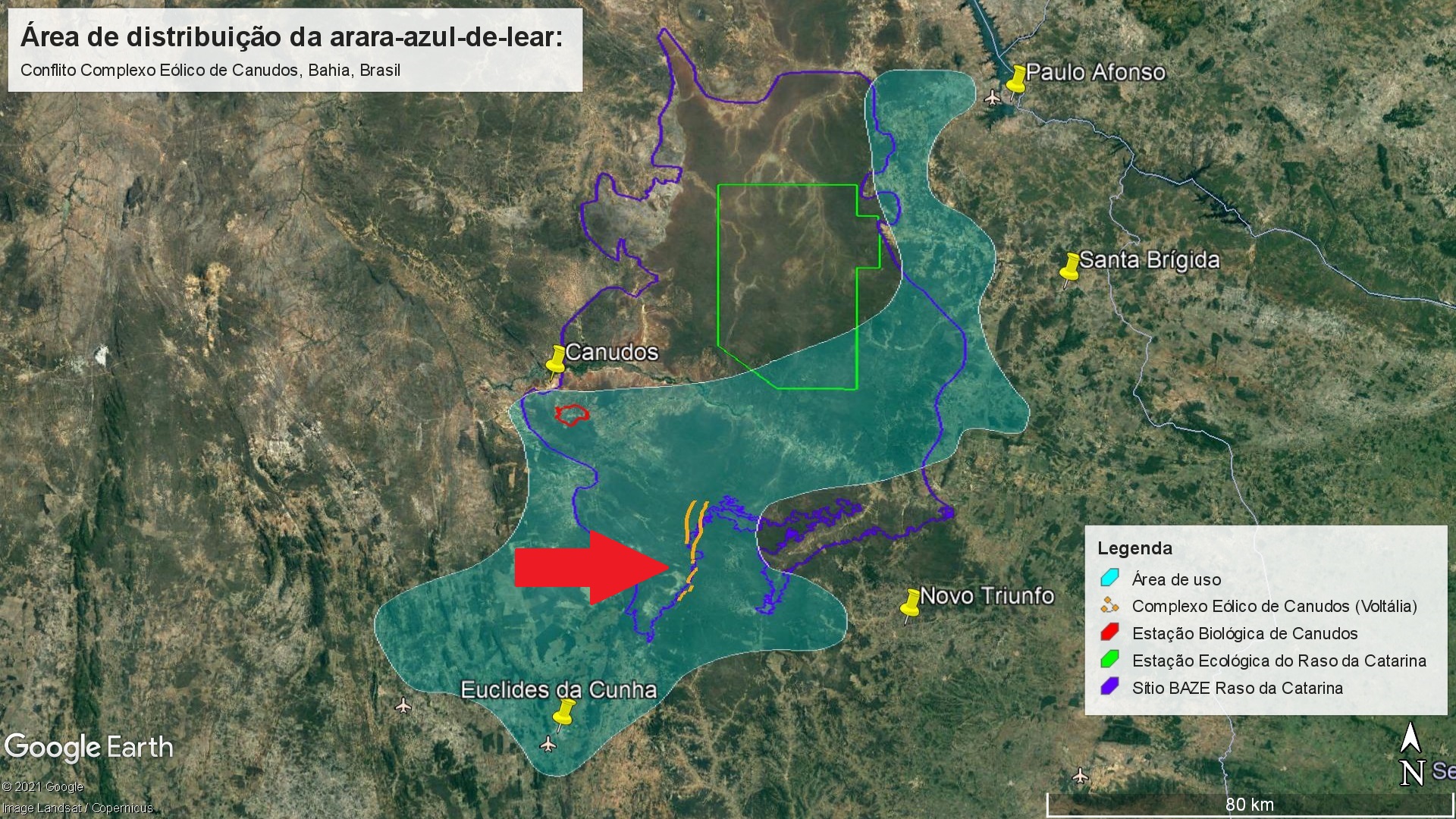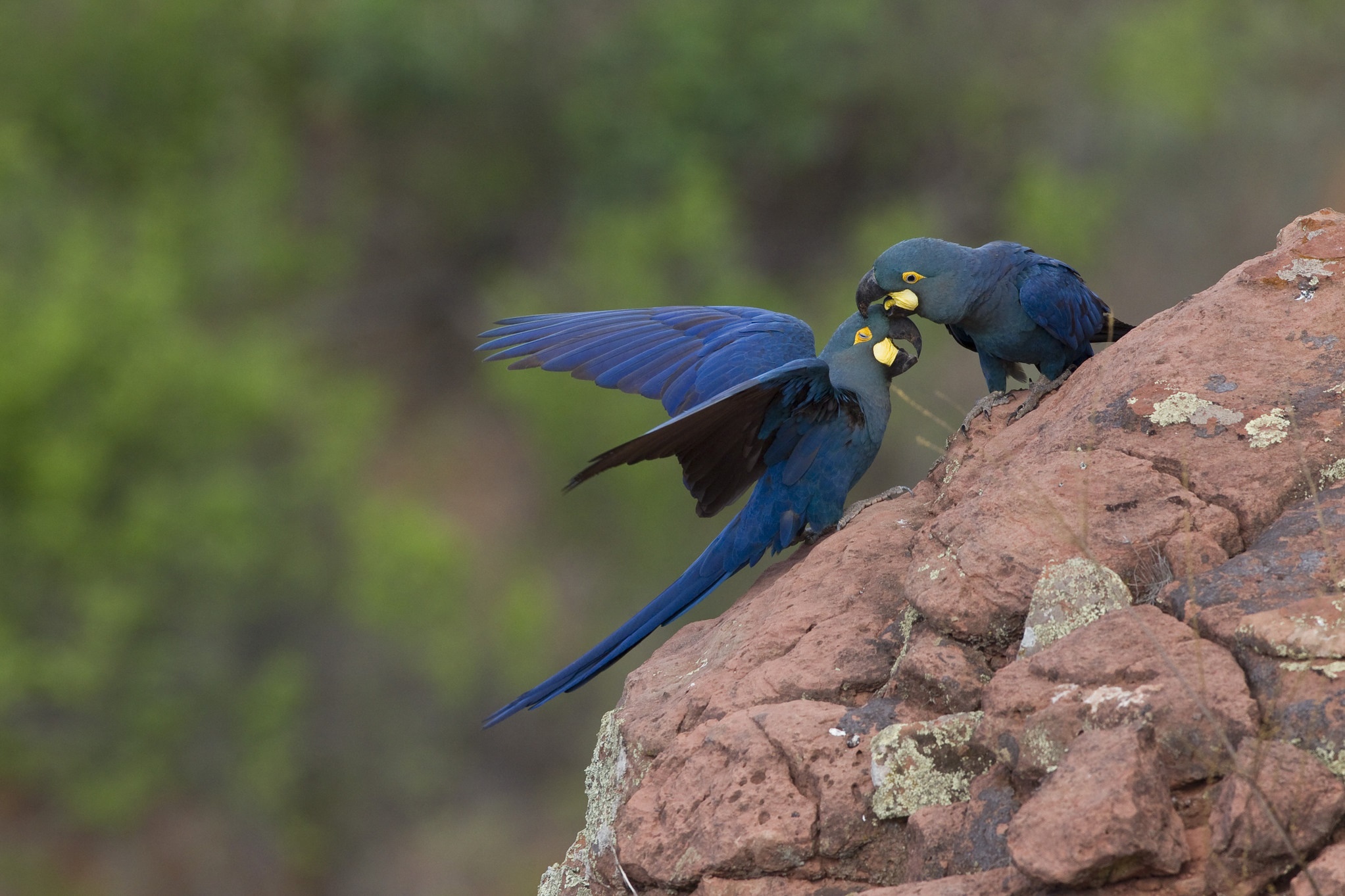- French renewable energy developer Voltalia plans to install 81 wind turbines in Brazil’s Bahia state, in an area that’s also the main refuge of the endangered Lear’s macaw (Anodorhynchus leari).
- Conservationists warn that the birds may collide with the turbines, especially because they fly at dawn and dusk, when visibility is poor.
- Fewer than 1,500 Lear’s macaws remain in the area; the species also suffers as a result of trafficking for the illegal pet trade.
- Voltalia says it is taking measures to reduce any impacts on the bird, and has also committed to its conservation; but critics say more complete impact assessments are needed before construction should be allowed to begin.
Conservationists in Brazil have raised alarms about the impact of a wind farm being built in a region that’s the last stronghold of the endangered Lear’s macaw.
French renewable energy developer Voltalia has started construction of the facility in Canudos, in the northeastern state of Bahia. It will install 28 turbines for the first stage of the project and another 53 in the second stage.
The project will also include a 50-kilometer (30-mile) power transmission network. All the electricity produced will be sold to the Minas Gerais Energy Company (Cemig) under a 20-year contract.
This same region is also the main refuge of the Lear’s macaw (Anodorhynchus leari), an iconic blue parrot whose population in the wild is estimated at fewer than 1,500 individuals.
The birds fly long distances every day, about 60-80 km (40-50 mi). They leave their roosts at dawn to feed, primarily on the small coconuts of the licuri palm, and return in the evening in flocks.
“We see the operation of a wind farm in the area where Lear’s macaws occur as risky,” says Gláucia Drummond, who heads the Brazilian NGO the Biodiversitas Foundation. “The species flies in pairs and flocks, so a single collision event could result in the death of many individuals and compromise their population viability in the short term — that is, extinguish the species.”
For 30 years, Biodiversitas has maintained a private area of 1,500 hectares (3,700 acres) in the region, the Canudos Biological Station. Working with other Brazilian and foreign organizations, they developed a conservation program that includes monitoring Lear’s macaws and protecting their feeding and roosting areas, as well as researching their behavior and conducting environmental education projects.
The Lear’s macaw was first described in 1856, but its range remained unknown for the next century. It was only in 1978 that researchers pinned down its habitat, in the region known as Raso da Catarina in the Caatinga scrubland biome. The area is today considered a “key site” by the Global Alliance for Zero Extinction, and a priority area of extremely high importance for Caatinga conservation by Brazil’s Environment Ministry.
The first census of the species, carried out in 2001 by Biodiversitas and the government’s National Center for Bird Conservation (CEMAVE), indicated a population of just 228 individuals. In the latest census, in 2019, there were nearly 1,500.
The increase in population led an improvement in the conservation status of the Lear’s macaw in 2011, from critically endangered to endangered.

Rules call for full environmental compliance
According to Biodiversitas, a key problem with the wind farm project is that Voltalia did not need to submit the full slate of required environmental documents to obtain permission for construction to begin.
A resolution by Brazil’s National Environmental Council (CONAMA) requires an environmental impact assessment (EIA) and an environmental impact report (RIMA as it’s known locally), in addition to public hearings, for wind farms located in “in areas with occurrence of threatened species and restricted endemism.”
But the Bahia state environmental authority, INEMA, approved the project after only simplified documents were submitted. “We want the law to be complied with and all steps followed,” Drummond says.
In an email, Voltalia said that “all the company’s projects strictly follow Brazil’s Environmental Legislation and have all the licenses required for construction and operation.” In a second message, the company said it has “conducted studies to assess social, economic and environmental impacts and benefits, with proposals to control/mitigate impacts on local fauna and flora, reaffirming that the project has all the licenses required for the current stage. The company also stresses its commitment to the environment and emphasizes that actions to preserve the macaw’s environment will not cease during the operation of the enterprise. It is a continuous and long-term work, which will go hand in hand with Voltalia’s presence in the region.”
Neither INEMA nor CEMAVE had responded to Mongabay’s questions about why the full documents were not requested from Voltalia as of the time this article was originally published in Portuguese.

Risk of colliding with turbines
One of the criteria set by INEMA to grant a preliminary license to Voltalia was the creation of a conservation program for the Lear’s macaw, before the start of the wind farm’s operations. The company hired biologist Erica Pacífico, one of the country’s leading experts on the species, who has done consulting work for other energy companies.
She says she believes in Voltalia’s commitment to mitigating its impacts on the macaws as much as possible. She notes that, following her recommendation, the company changed the access routes to the wind farm that crossed important feeding areas for the birds, for example. She also says that, in order to avoid the risk of electrocution, the medium voltage network will be installed underground.
“There is no evidence that the macaws’ flight path crosses the wind farm,” Pacífico says. However, she acknowledges that the birds’ path may change at different times of the year and in response to rainfall patterns.
Pacífico says other technology and tools will be deployed to minimize any impacts on the birds, including tagging of some of the macaws with GPS devices to map out the species’ home range.
Voltalia says it’s also considering painting the blades of its turbines black, since some research suggests this can prevent collisions. It adds it will implement technology to monitor the presence of the birds so that the turbines can be quickly shut down. However, when asked whether peak energy production times would coincide with periods of higher bird presence, the company did not respond.
Pacífico says there’s no information about macaws’ interaction with wind farms. “At this point, any allegations about that are unfounded,” she says. “The basic ecological information about the species does not allow us to make any inferences about the risks of impacts and therefore any such claims lack scientific basis.”

Lack of funding for species conservation
Despite Voltalia’s stated commitment to the Lear’s macaw, the highly threatened mascot of the Caatinga, the project faces criticism because its impact studies will only be done after the wind farm goes into operation.
“We are very concerned about the project in the geographical range of a threatened species,” says Joel Merriman, director of the American Bird Conservancy’s Bird-Smart Wind Energy Program. “Loss of even one Lear’s macaw would be too many. Part of the reason for this is that this is a long-lived, slow-reproducing species, so they have less ability to recover from losses than other species.”
He says the macaws’ habit of flying precisely at low-visibility times — at the beginning and the end of the day — seems to pose an even higher risk of collisions. Merriman says studies also show that birds don’t just collide with wind turbine blades, but also with the structures, which rise to 100 meters (330 feet) in height on average.
“There isn’t enough information; it’s still being collected. But the company is not waiting ,” Merriman says. “It is essential that we have all the data. Wind turbines are not made for all places. They are simply not suitable for some locations. And the existence of several [wind] parks ends up becoming a disaster.”
He cites a 2017 scientific paper that looks at the risk of collision for birds and bats according to their morphological and behavioral characteristics. He says it shows that “parrots (Psittaciformes) have a relatively high risk of collisions in general … and there is good reason to believe this applies to Lear’s macaws.”
Voltalia has another wind project in Rio Grande do Norte state and a project for a small hydroelectric plant in Amapá state. Pacífico says more companies will explore the potential of wind power in Brazil, and that working alongside a developer like Voltalia is a chance to get resources to fund the Lear’s macaw conservation program, given the dearth of government funding.
“The species is already facing the threats of wild bird trafficking, urban expansion and lack of a protection strategy for licuri, which suffers from deforestation and trampling due to overgrazing,” she says. “We don’t have resources for preservation in Brazil.”
Banner image of Lear’s macaws in the Raso da Catarina region. Image by João Marcos Rosa.
This story was first reported by our Brazil team and published here on our Brazil site on June 3, 2021.
